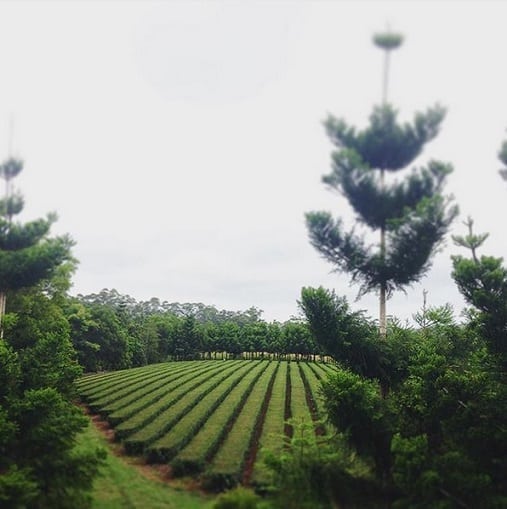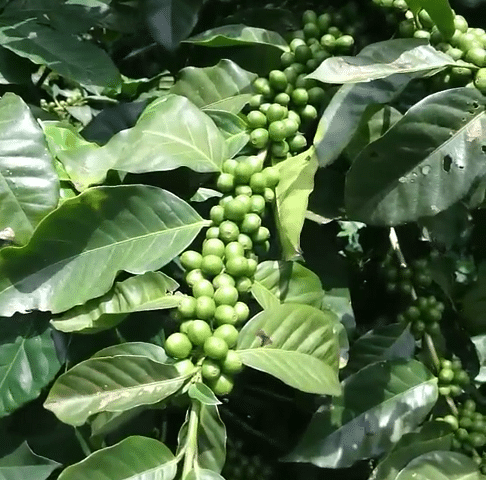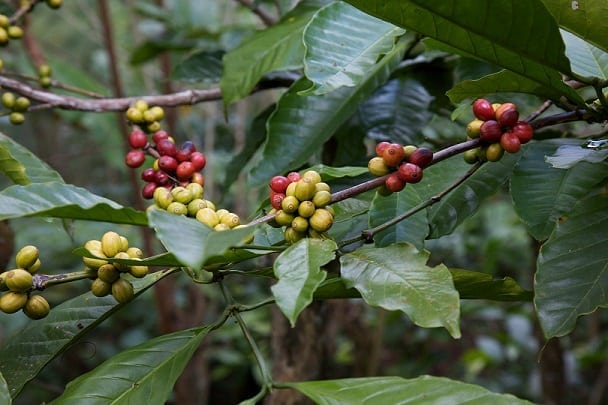The family Collins, purveyors of the Arakai Estate, have had a busy year.

Image owned by the Arakai Estate.
Which is a bit of an understatement.

The family Collins, purveyors of the Arakai Estate, have had a busy year.

Image owned by the Arakai Estate.
Which is a bit of an understatement.
In the spring of 2013, I tried a tisane made from the dried leaves of a Hawaiian coffee plant.

Arabica coffee plant. Image owned by Wize Monkey.
And I wasn’t a fan.
The flavor was not overly offensive, just . . . herbal. And nutty. Nutty-herbal. Okay, on “Internet” paper that doesn’t sound too terrible or unappetizing, but it wasn’t very palatable, either. It reminded me of nettle leaf that had gone slightly off. It would take another two years before I’d revisit the prospect of trying it again.
At World Tea Expo 2015, such an opportunity arose. The culprit? Wize Monkey.
NaNoTeaMo, Day 25: “Cáscara Té Amo”
When I first started doing “NaNoTeaMo” at the beginning of this month (i.e. a tea blog every day in November), I also chose use it as a hashtag. What I didn’t know was . . . the hashtag was already in use for something else. And I had no clue what it meant.
The hashtag in question was “#NaNoTeAmo” – the “A” was capitalized. It was Spanish for something. I asked my sister – who was fluent – what it stood for.
She said, “Um . . . Nano Loves You (?).”
I dunno who “Nano” is, or who he presumes to love, but I chose to stick with the “NaNoTeaMo” moniker for this little self-challenge, anyway. It was too late to change it up, now. Regardless of how confusing the Spanish derivative of it was. And speaking of confusing Spanish things, that makes a great (if awkward) segue into my next topic.
Cáscara.

Yesterday was just like any other day. I got up (far too) early, made a pint o’ Earl, poured cereal, basked in the morning meditation, then went to work. While at work, I did what I normally did…found moments of quiet solace to check my phone. Imagine my shock-‘n-awe when I was greeted by several updates on the Plus That Is Google feed about Teavana being bought out…
By Starbucks.
For 620 million dollars.

The one who broke the news to our little pocket of the tea community was Rachel Carter of I Heart Teas, and our steeping subculture dropped its collective jaw. It took me a moment (or five) to effectively collect mine from the proverbial floor. At first, I wanted to nerd-rage, but then…I had a moment to think on the implications. This might actually be a good thing, I mused.
I have a love-hate relationship with Teavana, as most right-thinking steep-people (steeple?) do. On the one hand, their blends are awesome. C’mon, you know they are – if you’re in to that sorta thing. They actually made chamomile ice-able. That alone deserves a gold star. What aren’t so great are their upselling practices.
Only one example comes to mind: I was hunting down a specific blend with strawberries in it, and the douche-y bro-vendor tried to sell me genmaicha blended with popcorn. No, not the regular rice-popped stuff in normal genmaicha. Actual popcorn. I don’t like genmaicha, and I loathe wet popcorn. He insisted it had a strawberry smell, and I wanted to hit him repeatedly with a canister.
My most infuriating exposure to the tea chain was when I interviewed for them. *Le sigh* Yes, I actually applied for a job at one of their locales. Judge away. During the interview, I was given an opportunity to drink tea while talking. Bad idea, since I was motormouthing a mile a minute. Everything was going relatively well until the interviewer said this phrase:
“We aren’t exactly used car salesmen, but we walk the fine line.”
Everything went downhill from there. Needless to say, I didn’t get the job. I’m a tea geek, sure, but I’m not a salesman. I don’t even look the part. (I.e. I’m not a cute girl in librarian glasses. Same reason I didn’t get tea jobs elsewhere.)
In short, my history with the chain is dicey but amicable. When I read of the buy-out, I immediately thought of Starbucks’s in-house label, Tazo. While they did little to change the philosophy of that brand, from what I heard from others, there was a slight dip in quality. However, in recent years, they seem to have changed their practices a bit. Example: Switching from teabags to tea sachets for their retail line.
Speaking of retail, Starbucks earlier announced that Tazo would be turned into a brick-‘n-mortar op a la Adagio. If they already had a brand, why the acquisition of another? The answer was obvious.
I couldn’t help but compare the buy-out to another famous acquisition from a couple of weeks back. Starbucks was Disney, and Teavana was Lucasfilm. Think about it.
Teavana started off as a boutique op out of the unassuming – and un-tea-like – locale of Atlanta, GA. At first, they were focused on bringing knowledge of loose-leaf tea to the masses. However, as they grew, so did their marketing strategy. In the successive (and successful) years, they became known for some questionable decisions.
Lucasfilm started off as a bastion for truly independent filmmaking. Self-sufficient and self-sustaining. As decades rolled by, their acumen changed. Star Wars, once a property that could do no wrong, was given a corporatized treatment in later incarnations. And it showed. Oh, dear God, did it show.
Disney is a bloated behemoth, and so is Starbucks. Both started off in idealistic territory, but grew too big for their britches. However, in recent years, something has shifted. They’ve taken risks. Some have paid off, others haven’t. In the case with Disney, they made John Carter and The Avengers. One bombed, the other was a blockbuster. Starbucks’s brick-‘n-mortaring of Tazo could be viewed in the same light.
What I’m saying is this: Starbucks may be on to something. There’s no denying that a tea renaissance – to coin James Norwood Pratt – is in the making, much like the “third wave” coffee movement of yesteryear. It is only natural for a large company to look at the potential of that and act on it accordingly. For better or worse, Teavana was one of the most familiar names in tea, right behind Lipton. Questionable, though there approach was, they did stress the strengths of loose leaf tea over teabags.
Perhaps the Starbucking of Teavana might gentle some of its more questionable practices. That might be wishful thinking, but – other than the price for macchiato – Starbucks still has an accessible brand. I’m personally looking forward to seeing what happens, just like I’m looking forward to a new Star Wars movie.
With cautious optimism.
“Ersatz” is a German word that roughly translates to “substitute or replacement”. English speakers adopted it to refer to an inferior copy of something else. The original definition, however, does not indicate that the duplicate need be inferior – merely alike. My first exposure to the word arrived in two different ways the same year – one while reading a textbook (and falling asleep), the other used by a very glib and verbose friend of mine (who made me fall asleep). Of all the scholastically snobby traits I’ve developed, the use of “ersatz” never entered my lexicon. (Although, I still use “lexicon” regularly.)
The unique word was recently adopted by an outfit in Bellefonte, PA., called the Coffee Trade Company. In a “charmingly anachronistic” fashion (their words), they developed a coffee substitute that differed from others on the market. Most coffee subs I’ve encountered contain some combination of three ingredients – barley, chicory, and dandelion root. The last of which is often used as the primary.

On an attempt to find a coffee clone I liked, I experimented with a dandelion/chicory blend and straight roasted dandelion root. The results were underwhelming. On a later brew-up, I tried a Japanese barley tisane (mugicha) and found it quite delightful. While I didn’t experiment with blending any further, I readily assumed that those three were the magic ingredients for creating the perfect “coffaux”.
Ersatz went a completely different route, sidestepping the barley and dandelion entirely. They kept the chicory – likely for coloring purposes – but used roasted peas and roasted ri-…wait, did I read that right? Roasted rice?
Drat.
If it hasn’t been made apparent, I’m not a fan of rice as a tea additive. Genmaicha – the premier rice-blended green tea – is my least favorite. There’s only been one rice-flavored anything I ever favored drinking, a sticky rice pu-erh, and actual rice wasn’t included. In my palate opinion, rice can only be eaten, not steeped. And, yes, I’m fully aware that I’m in the minority.
To Ersatz’s credit, the blend smelled wonderful. It was equal parts toasty, roasty, earthy, woody, and…well…manly. There was a rough, wildernessy feel to the aroma, like coffee on a campground. Rice was not the dominant presence, nor was the tangy chicory. I hoped that carried through in the taste.

Brewing instructions were dead simple. It was a large teabag, and the ingredients were strong herbals. Great care wasn’t necessary. All I had to do was dunk the bag in a cup of boiled water for three-to-five minutes, and I was done. I tested the bag out at a full five minutes.
The result was a cherry-wood-to-dark-brown liquor with a strong “cooked trail mix” aroma. In all honesty, it didn’t smell like coffee. The smell sort of reminded me of barley but with less emphasis on the roasted characteristics. To the taste, it started out well enough, imparting a toasted/herbal profile but quickly translated into something I didn’t favor. There was the rice, I thought to myself. Two-thirds of the blend was wonderful and almost coffee-like, but the rice-reared finish was off-putting.

Not willing to admit defeat, I dared a second brew-up – this time at the three-minute mark. The liquor infused to the same deep brown but slightly lighter. The aroma was just as toasty as the lengthier infusion but a bit gentler on the nose. The flavor was a welcomed relief. All roasty/toasty beverage, no rice; if there was a rice presence, it was thankfully muted. Toasted veggies, smoked herbs, and an urge to go hiking were the only impressions imparted. The real joy came with the inclusion of milk and stevia. Now that was where it reminded me of coffee. Any faint rice-recoil was permanently subdued by the addition of dairy and sweet things.

I would be hard-pressed to call this end-all/say-all substitute for coffee. Having talked to my fair share of goths, hipsters, clock-punchers, and wired hackers, they will never give up their coffee. Ever. The flavor only leaves a faint impression of the blunt-force wake-up bean. That said, I could see a coffee drinker enjoying it as a nightcap. I certainly did.
But now I have a strange desire to write beatnik poetry…about clones. Why is that?
To buy Ersatz Coffee, go HERE.
Powered by WordPress & Theme by Anders Norén